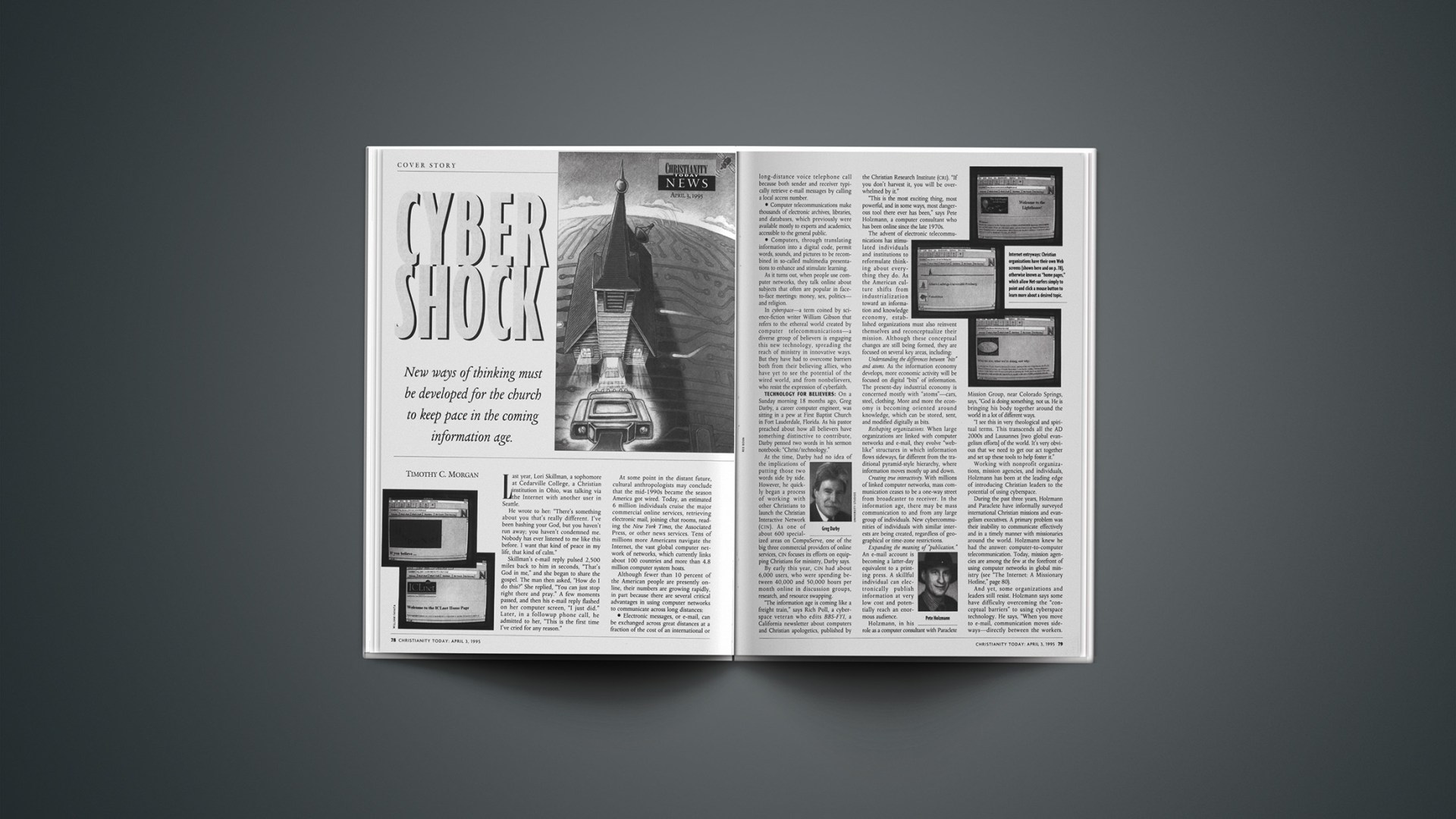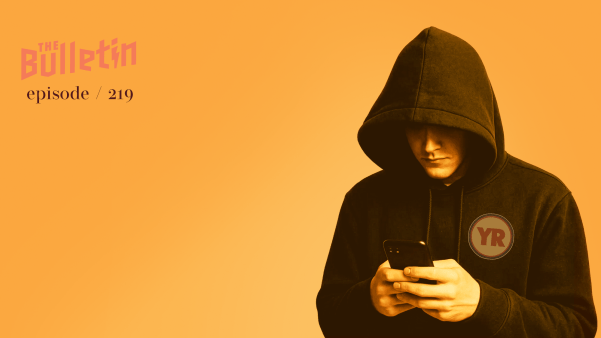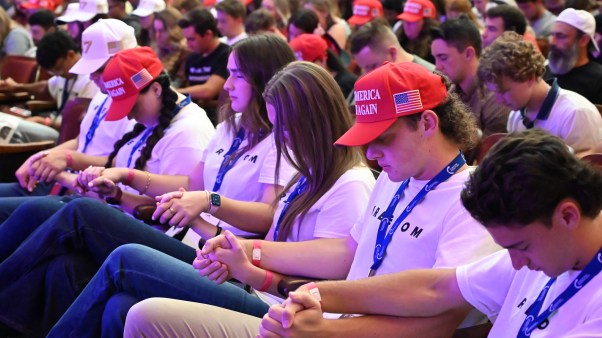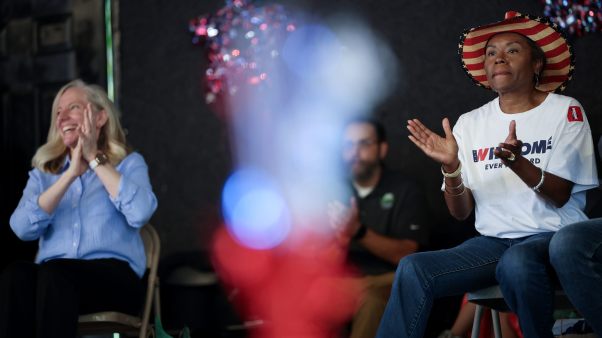Last year, Lori Skillman, a sophomore at Cedarville College, a Christian institution in Ohio, was talking via the Internet with another user in Seattle.
He wrote to her: “There’s something about you that’s really different. I’ve been bashing your God, but you haven’t run away; you haven't condemned me. Nobody has ever listened to me like this before. I want that kind of peace in my life, that kind of calm."
Skillman's e-mail reply pulsed 2,500 miles back to him in seconds. "That's God in me," and she began to share the gospel. The man then asked, "How do I do this?" She replied, "You can just stop right there and pray." A few moments passed, and then his e-mail reply flashed on her computer screen, "I just did." Later, in a followup phone call, he admitted to her, "This is the first time I've cried for any reason."
At some point in the distant future, cultural anthropologists may conclude that the mid-1990s became the season America got wired. Today, an estimated 6 million individuals cruise the major commercial online services, retrieving electronic mail, joining chat rooms, reading the New York Times, The Associated Press, or other news services. Tens of millions more Americans navigate the Internet, the vast global computer network of networks, which currently links about 100 countries and more than 4.8 million computer system hosts.
Although fewer than 10 percent of the American people are presently online, their numbers are growing rapidly, in part because there are several critical advantages in using computer networks to communicate across long distances:
- Electronic messages, or e-mail, can be exchanged across great distances at a fraction of the cost of an international or long-distance voice telephone call because both sender and receiver typically retrieve e-mail messages by calling a local access number.
- Computer telecommunications make thousands of electronic archives, libraries, and databases, which previously were available mostly to experts and academics, accessible to the general public.
- Computers, through translating information into a digital code, permit words, sounds, and pictures to be recombined in so-called multimedia presentations to enhance and stimulate learning.
As it turns out, when people use computer networks, they talk online about subjects that often are popular in face-to-face meetings: money, sex, politics—and religion.
In cyberspace—a term coined by science-fiction writer William Gibson that refers to the ethereal world created by computer telecommunications—a diverse group of believers is engaging this new technology, spreading the reach of ministry in innovative ways. But they have had to overcome barriers both from their believing allies, who have yet to see the potential of the wired world, and from nonbelievers, who resist the expression of cyberfaith.
Technology for Believers
On a Sunday morning 18 months ago, Greg Darby, a career computer engineer, was sitting in a pew at First Baptist Church in Fort Lauderdale, Florida. As his pastor preached about how all believers have something distinctive to contribute, Darby penned two words in his sermon notebook: "Christ/technology."
At the time, Darby had no idea of the implications of putting those two words side by side. However, he quickly began a process of working with other Christians to launch the Christian Interactive Network (CIN). As one of about 600 specialized areas on CompuServe, one of the big three commercial providers of online services, CIN focuses its efforts on equipping Christians for ministry, Darby says.
By early this year, CIN had about 6,000 users, who were spending between 40,000 and 50,000 hours per month online in discussion groups, research, and resource swapping.
"The information age is coming like a freight train," says Rich Poll, a cyberspace veteran who edits BBS-FYI, a California newsletter about computers and Christian apologetics, published by the Christian Research Institute (CRI). "If you don't harvest it, you will be overwhelmed by it."
"This is the most exciting thing, most powerful, and in some ways, most dangerous tool there ever has been," says Pete Holzmann, a computer consultant who has been online since the late 1970s.
The advent of electronic telecommunications has stimulated individuals and institutions to reformulate thinking about everything they do. As the American culture shifts from industrialization toward an information and knowledge economy, established organizations must also reinvent themselves and reconceptualize their mission. Although these conceptual changes are still being formed, they are focused on several key areas, including:
Understanding the differences between "bits" and atoms. As the information economy develops, more economic activity will be focused on digital "bits" of information. The present-day industrial economy is concerned mostly with "atoms"—cars, steel, clothing. More and more the economy is becoming oriented around knowledge, which can be stored, sent, and modified digitally as bits.
Reshaping organizations. When large organizations are linked with computer networks and e-mail, they evolve "weblike" structures in which information flows sideways, far different from the traditional pyramid-style hierarchy, where information moves mostly up and down.
Creating true interactivity. With millions of linked computer networks, mass communication ceases to be a one-way street from broadcaster to receiver. In the information age, there may be mass communication to and from any large group of individuals. New cybercommunities of individuals with similar interests are being created, regardless of geographical or time-zone restrictions.
Expanding the meaning of “publication.” An e-mail account is becoming a latter-day equivalent to a printing press. A skillful individual can electronically publish information at very low cost and potentially reach an enormous audience.
Holzmann, in his role as a computer consultant with Paraclete Mission Group, near Colorado Springs, says, "God is doing something, not us. He is bringing his body together around the world in a lot of different ways.
"I see this in very theological and spiritual terms. This transcends all the AD 2000s and Lausannes [two global evangelism efforts] of the world. It's very obvious that we need to get our act together and set up these tools to help foster it." Working with nonprofit organizations, mission agencies, and individuals, Holzmann has been at the leading edge of introducing Christian leaders to the potential of using cyberspace.
During the past three years, Holzmann and Paraclete have informally surveyed international Christian missions and evangelism executives. A primary problem was their inability to communicate effectively and in a timely manner with missionaries around the world. Holzmann knew he had the answer: computer-to-computer telecommunication. Today, mission agencies are among the few at the forefront of using computer networks in global ministry (see "The Internet: A Missionary Hotline," page 80).
And yet, some organizations and leaders still resist. Holzmann says some have difficulty overcoming the "conceptual barriers" to using cyberspace technology. He says, "When you move to e-mail, communication moves sideways—directly between the workers. Executives can feel out of the loop."
Denominational Dialogue
Although most local churches, denominations, and nonprofits have yet to breathe the rarefied technological air in cyberspace, a few others have been acclimated since the early 1980s. Ecunet began in 1982 and represents the joint efforts of 20 major religious groups, including Presbyterians, Baptists, Anglicans, Roman Catholics, and Jews.
"There's been a considerable difference between the ecumenical community and the evangelical community with regard to computer networking," says Robert Cramer, one of the founders and former board members of Ecunet.
"Evangelicals have been really slow in this area, though they were among the first in television," Cramer says. "Mainline denominations have been communicating on computer networks for ten or more years." At present, Ecunet has 5,500 members, many of them local church leaders or denominational staff members. The Ecunet system provides electronic meeting places, where individuals share opinions, subscribe to a denominational news service, or post notices concerning urgent ministry needs around the world.
Many e-mail users find one of its most appealing qualities is that it allows considerable intimacy among people who would otherwise be strangers, dissolving temporal and ideological boundaries. Online relationships with people who have never met in the flesh have become a daily reality for millions of people. Roger Bolz, an executive with Episcopalians United (EU), a conservative reformist group, has found that within Ecunet, theological disagreement is often more reasoned and better articulated than it would be in live, spontaneous debate. "We have been taking a winsome approach. Speaking clearly and articulately takes longer than a live conversation," Bolz says. "It's a good place to talk to folks who disagree with us and have very amicable conversations." The Southern Baptist Convention, the nation's largest Protestant denomination, has become another major religious organization to take the leap of cyberfaith. In 1993, it moved to set up its own computer network, SBCnet. Also on CompuServe, SBCnet provides SBC churches with news, information, Sunday-school curriculum, and discussion groups. To date, 3,690 local churches and individuals are online with SBCnet. This year, the network hopes to link its seminaries and agencies into the network.
Christianity Online
One of the most recent debuts in cyberspace has been Christianity Online (COL), a new effort by Christianity Today, Inc., publisher of Christianity Today and seven other evangelical magazines, all of which are available online. As part of the burgeoning America Online (AOL), now the most active commercial online service with more than 2 million members, Christianity Online has been growing rapidly.
Launched six months ago, Christianity Online is currently receiving about 325,000 monthly visits, with online participants logging in excess of 32,000 hours a month. John LaRue, head of Christianity Online, notes that more people use the chat rooms, which feature live online discussions, than use the message boards, which involve focused discussion on dozens of topics over time. But both features are extremely active. LaRue says, "Christians like to talk!" This year, COL will be adding a resource center, classified ads, an education section, a ministries section, and a products center. LaRue says, "We've had over 150 organizations saying that they want to go online with us."
CIN's Darby believes there should be a strong Christian presence in all the major online services. "We're all working for the same boss," he says.
All of the big three online services, AOL, CompuServe, and Prodigy, also provide general religion areas, in which a cornucopia of world faiths are represented. Usage reports show that these religion areas are among the most frequently visited areas. One of the effects of e-mail has been to dissolve many polite conversational conventions. People are thus more willing to explore religious questions and engage in debates surrounding religious issues.
The Emerging Cyberculture
In January, Newt Gingrich, making one of his first ventures into shaping public opinion as the new Speaker of the House of Representatives, participated in a symposium in Washington on the emerging information culture.
At the event, Gingrich defended his idea that the poor should be given ready access to computers to participate fully in the coming "information age." He said, "Somehow there has to be a missionary spirit in America that says to the poorest child in America, 'Internet's for you. The information age is for you.' "
Federal census figures show that 27 percent of white, 1.4 percent of African American, and 13 percent of Latino households have personal computers. The reality of the gap between "information-haves" and "have-nots" has become an unintended consequence of the emerging cyberculture and will likely defy a simple solution.
Philip Elmer-DeWitt, senior editor at Time, has been covering the cyberspace beat since the early 1980s. He says, "There's a financial barrier to playing online. If you look at cable TV, the rich and the elderly don't buy cable. The poor have a high use of cable TV [but] don't spend a lot for computers, not like middle-class white families.
"The gap between the information haves and have-nots is huge now," Elmer-DeWitt says. "Money is less a barrier than you might think. It really has more to do with values." He also points out that large rural areas are being marginalized in the information age because the local nodes, which provide cheap phone access to online services and the Internet, are not as prevalent as in large, urban population centers.
This unresolved gap between the information rich and poor is but one of many issues that experts, academics, and government officials are exploring. If the information gap remains unresolved, the information poor may be marginalized in educational and career opportunities.
Another critical area involves whether there will continue to be robust freedom of speech online. One of the most widely used components of the core Internet is a worldwide network of discussion groups called USEnet.
There are more than 5,000 USEnet groups, linking millions of Internet users in familiar, obscure, and potentially offensive discussion groups. Two of these groups made national news in recent months. In one USEnet group, a Michigan student was arrested in connection with posting an explicit story involving the fictional rape and murder of an actual female student on campus. In the second instance, another discussion group, "alt.religion.scientology," drew the intense scrutiny of the Church of Scientology when someone posted material that church officials said was secret, protected by copyright, and had been stolen during a computer break-in. The church has taken the unusual step of launching an international electronic manhunt to uncover the person's identity.
In addition to USEnet, thousands of other special-interest groups are communicating via Listserv and Majordomo software, which function by sending an e-mail message to a list of subscribers. Some lists have thousands of members who send and receive messages every day. Recently, one message poked fun at a new "cyberdisorder" among e-mailers: Chronic Posting Syndrome.
Among the enduring features of the Internet subculture is its resistance to centralized authority, frequent disdain for copyright laws, and willingness to "bring to the party" inexpensive computer software and information to be shared.
It also has been a place where hostility toward religion has been commonplace despite the diversity and depth of religion resources on the Internet.
Martin Bush, system administrator of ICLnet, founded by the Institute for Christian Leadership in Tigard, Oregon, recalls his extensive experiences in computer bulletin boards and Internet discussion groups, saying there has been "a real culture of anti-Christianity."
"If you ever identified yourself as a Christian, you really opened yourself up for serious attack," Bush says. The Internet "is still a very scientifically oriented community." In its earliest days, the Internet was a network of mostly scientists, technicians, and computer programmers. They still make up a large percentage of Internet users.
ICLnet has foiled several attempts by computer "hackers" to break into its computer network. Sometimes, individuals will leave behind "pretty nasty e-mail notes," Bush says, when they discover that ICLnet hosts one of the world's largest archives of online Christian material. The archive, which is accessed about 1,000 times daily, encompasses classic Christian texts, curriculum materials, newsletters, discussion groups, and Christian history resources.
In addition to resisting hostile individuals, others, such as Curt Byers, associate pastor of the Grantham Church on the campus of Messiah College in Grantham, Pennsylvania, foresee greater difficulties for Christians and church leaders. Byers has been a computer consultant for Christian ministries for several years.
"It's the frog in the kettle syndrome," Byers says. "The average Christian struggles with 15 minutes of devotions [daily] and an hour in a church [weekly] and then spends five hours a day watching totally secular media. If we have not been savvy about what that's been doing to us, I just despair of our ability to understand this far more immersive media." Byers views cyberspace as being "both stunningly glorious and wonderful and terrifying."
The dark side of cyberspace has gained greater attention as the national news media have moved beyond surface-level hype of the Internet into its netherworld. As scholars and experts explore the dangers of cyberspace, the issues they are examining include:
Free speech restrictions. The "Communications Decency Act," now before Congress, would penalize anyone using electronic telecommunication to harass, defame, or to spread obscenities. So-called cyberporn continues to worry Christian leaders (see CT, Sept. 12, 1994, p. 42). And many Christian networks limit access to the Internet to protect children from exposure to online pornography.
Security. An Internet underground continues to break into computer networks, stealing software, credit cards, and damaging systems.
False relationships. When individuals interact online, normal interpersonal boundaries do not exist, allowing individuals to conceal their true identity by assuming online personas. When advising Christian leaders, Byers says he advocates "ruthless exploitation of what good there is" by as many different sectors of Christian ministry as possible. At the same time, he and other Christian leaders see many potential pitfalls; for example: rogue believers who engage in "flame wars," in which hateful e-mail is rained on those who disagree with them; insensitivity to the cross-cultural barriers that remain in spite of instantaneous global communication; and the danger that the moral dimension of behavior may become increasingly irrelevant in cyberspace.
Problems and Opportunities
When Morse Tan was in second grade, he wanted an Atari computer so intensely that he broke down and cried after he received a Bible instead as a gift. Now a premedical student at Wheaton College in Illinois, Tan has found a way to merge his passion for computers and his faith: ComputeReach.
Every Saturday, Tan and about a dozen other college students meet for prayer and then enter cyberspace. Tan says the ComputeReach ministry is "open to using any and all avenues of communication within computer networks: bulletin boards, news groups, e-mail, contact evangelism.”
"Each person has a unique area of ministry. We are on there, trying to put forth the biblical world-view."
Because colleges and universities in many cases have been wired for e-mail for more than a decade, the campus environment is being transformed.
Among Christian colleges, Cedarville has moved toward the head of the class in building an electronic network. The college has 95 percent of its campus wired to Cedarnet, which is itself plugged into the Internet. The college recently received national recognition for its campuswide network, which has nearly 1,000 personal computers in its dormitory rooms.
The Coalition for Christian Colleges and Universities (formerly the Christian College Coalition) recently polled its 90 member institutions to determine how and what they were doing with computer networks and the Internet. More than 65 of them are connected to some kind of Internet service. And many of them provide their students as well as remote users access to their archives and databases.
Other institutions are using e-mail for long-distance learning, student and faculty recruitment, and academic research. Dallas Baptist offers a two-way interactive video class to business school students who also use the Internet to exchange their views.
ICLnet's Bush, a former college professor, says the new information culture will have a lasting impact on higher education. "It's too attractive to go backwards. Some faculty members are resisting with everything they can because they want to hang on to the traditional model. I think it's a hopeless cause." Bush, whose network links 2,000 Christian faculty members in 47 countries, believes market pressures and rising costs will bring about greater use of computer networks and the Internet in college-level instruction.
Also at the forefront of the information age, the international missions community has been aggressively linking missionaries to their home offices, sharing archival information about languages and Bible-translation tools, and matching urgent needs with ready providers around the world. Global Mapping, Wycliffe/ Summer Institute of Linguistics, and MissionNet are three leaders among dozens of mission groups rapidly moving to use computers and telecommunications in their ministry.
Using God's Resources
Robert Sutterfield, senior systems engineer with Morning Star Technologies in Columbus, Ohio, spoke recently at a Chicago meeting of the Christian Management Association about the use of the Internet and online services. He advocates three things: "Be wise: Learn to take advantage of resources. Be responsible: Share your resources with others. Be frugal: Don't invent tools that probably already exist."
Sutterfield believes Christians should be using technology to be more "effective witnesses." In the Internet universe, where the world's religions are on display, Sutterfield sees a rich opportunity to "counter, not accommodate" by making the very best Christian material readily available online.
Because the cyberspace world is still largely word- and text-oriented, Christian apologists have discovered a renewed interest among online believers for the means to use critical thinking skills in discussing their beliefs.
"My heart bleeds in this area," says CRI's Poll. "If you were to contrast the cults to Christian organizations, especially evangelical organizations, the cults have by far a higher quantity per group of shareware resources available on disk and online than the church does. We're both wanting to win the interest of the nonbeliever."
For cyberspace newbies and veterans, finding one's way through the technological thickets and blind alleys of the Internet has fueled a cottage industry of online resource directories and road maps.
Although no expert claims to know exactly how the information culture will unfold, many Christians are not waiting on the sidelines before they find out. Jason Baker, at 24 years old already a veteran of the Internet and author of The Christian Cyberspace Companion (forthcoming from Baker), says, "We're still in the infancy stages. I'm an advocate of Christians playing a role in society, to work the ground—now in electronic form—to do this for God’s glory.”
The paradigm shift in modern culture from traditional industrial production to creation of new information and knowledge is gathering momentum and for some seems unstoppable. "It's not physically possible to censor the Net anymore," Sutterfield says. "It's not physically possible to tear it down anymore. There's no way to shut it off."
With reporting by Helen Lee.










